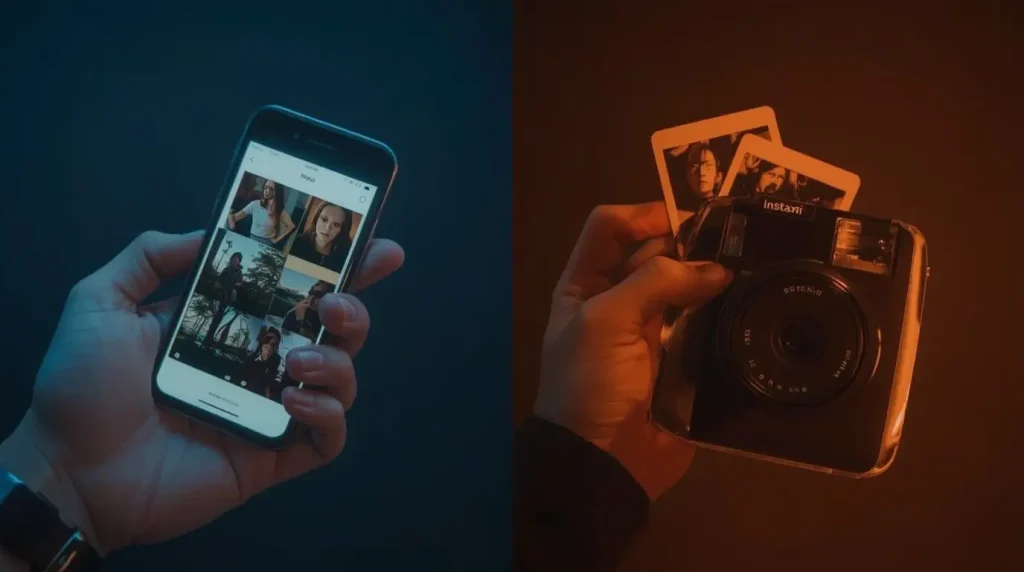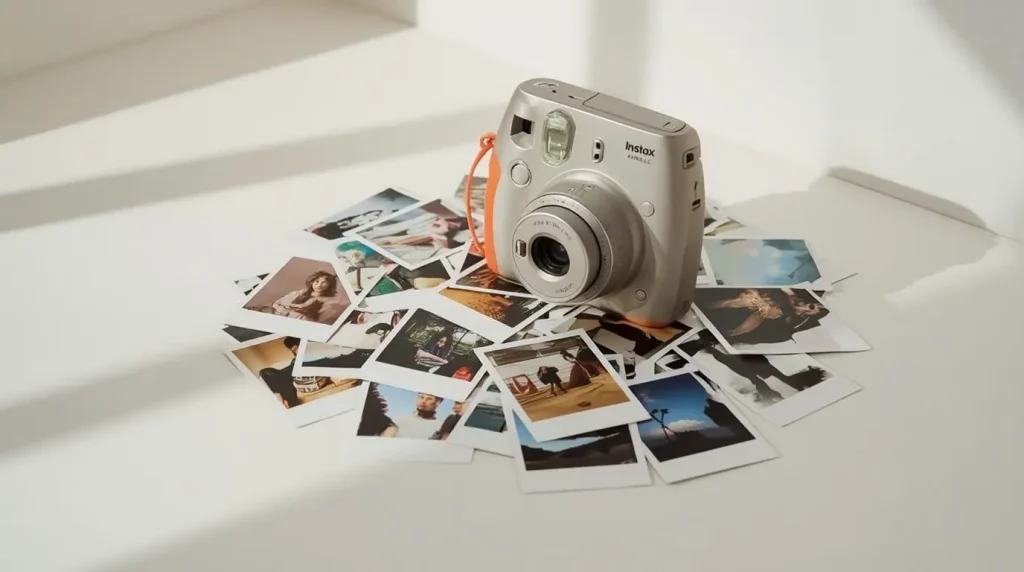The Unlikely Comeback of Instant Film in a 200-Megapixel World
Today, when our pocket-sized smartphones flash 200-megapixel shooters and software stitches photos into flawless sunsets in a split second, you’d think film cameras vanished for good. Yet in living rooms, school halls, and beach bonfires, the bulging, rainbow-swipe Instax camera still gets wheeled out. People who could flick-filter the perfect light instead point a shutter, wait a second for a smudgy rectangle to slide out, and smile. This rebellion—against unwavering sharpness, and against sharing before letting a moment breathe—tells us something. Instant photos don’t just document; they slow us down, and in that frame, they offer a fresh way to own, question, and even miss our memories.
Fujifilm doesn’t just make glossy Instax brochures, it keeps counting billion-selling pages. The click of the camera, the sneeze of neon color, the pixels in its pixels, all crafted a star-studded script. In April 2025, the company declared they’d cleared the 100-million-device milestone—now an asterisk in a world used to millions-per-week. That those cameras launched just a breath into the web age, crashed into a geyser of digital rules, and still bounced back to rewrite the script—now that part quiets even the snazziest data analyst.

The Origins of Instax: From Fotorama to Global Hype
Fujifilm’s story with instant photography started a lot earlier than today’s massive Instax craze. The Fotorama line rolled out way back in 1981. Japanese shoppers loved it, but outside the country, it didn’t spark the fire everyone was hoping for. The magic fire didn’t come until the 1990s. Engineers at Fujifilm noticed how Japanese teens went wild for purikura, the booth-style photo stickers everyone was using at the mall. They wondered, “What if we marry that instant, fun print-out vibe with a mini camera like our QuickSnap disposables?”
The answer appeared as the Instax Mini 10 in 1998. This cheerful little snapshot maker kicked out credit-card-sized prints—about 2 by 3 inches. Soon, it was Japan’s fun new toy. Fujifilm didn’t stop there. They rolled out the Instax WIDE, doubling the print size, and kept updating the Mini lineup with brand-new colors and designs. Just as things were heating up, tiny digital cameras and smartphones showed up, causing sales to dive in the early 2000s. Suddenly, it looked like Instax was going to be a short-lived prototype rather than the start of a new revolution.
The comeback for instant photos kicked off in 2012 with the launch of the Instax Mini 8, dubbed the “world’s cutest camera.” It caught on fast with teens across Asia. After Polaroid shut its instant film division—twice, 2008—Instax saw its chance. The brand finally rolled its products into the U.S. and other global markets in 2015.
The Modern Instax Ecosystem: Blending Classic and Digital
Fujifilm has built a whole ecosystem where the warmth of instant film meets today’s gadgets. No longer sticking just to film, the lineup now includes:
- Classic instant models: the Instax Square SQ6 and Instax Wide 400
- Hybrid cameras: the Mini LiPlay and Mini Evo, which store photos digitally
- Mobile printers: the Mini Link series turns phone pics into physical cards
- Limited-edition styles with pop stars and franchises, from Taylor Swift to Pixar
The launch of the “GENTLE ROSE” colorway for the Mini Evo hybrid is a perfect example. It adds chic aesthetics without changing the tech under the hood, letting fans grab physical prints after snapping with a built-in sensor. The Mini Evo has already scored hardware prizes from the Red Dot and iF festivals for its design.

New software updates keep growing how much you can do with any Instax camera. Back in June 2025, Fujifilm surprised everyone by bringing the popular “instax AiR Studio™” and “Click to Collage” effects, which used to live only on the Instax mini Link 3™, to earlier mini Link printers. All it took was a quick firmware update and features anyone thought were locked to the latest gadgets suddenly popped right up on older models. That kind of upgrade shows how refreshes can breathe new life into devices nearly anyone thought were “old.”
Why Instax Still Wins in a Digital-First World: A Psychological Look
Minilab popularity still stuns experts, especially in a culture obsessed with polished digital snaps. Ryuichiro Takai, head of Fujifilm’s consumer image division, sums it up: “This product is the exact opposite of any digital camera’s efficiency and sharp perfection. For anyone used to crisp, instant results, the pause of waiting for a photo to finish slowly developing becomes a kind of unexpected fun.” Because people so used to the snap-and-share cycle finally get to pause, the photo now becomes an event, not just a post.
Jaron Schneider, the editor-in-chief of PetaPixel, takes the thought a step deeper: “Gen Z and Gen Alpha are living in a future their older siblings now nostalgically romanticize. A generation that archives everything still lacks a real and fragmenting ‘first memory’ to scroll back through. So they turn to film prints and developing mugs, not because it’s trendy, but because prints are physical proof of experience that isn’t pixelated or automatically sorted by an algorithm.” In a lives shaped by swipe culture, the tactile, developing photo is not merely a snack memory; it’s an unplugged vacation.
Tokyo videographer Daishi Kusunoki tells me that picking up an Instax has changed the way he travels for work and play. “Film costs. Holding that money in your hand makes you stop and think. When I’m about to press the shutter I pay attention to where the light falls, where the shadow cuts in, how I’m framing the moment.
The bulk of the minute clicks that I used to rattle off with a smartphone disappeared. Suddenly I’m studying what makes an image pop, and the little effort to figure out the limiting downside that I used to complain about turns the moment into something I’m proud to hand to my pocket three minutes later. It’s a beginner’s proof and the retro buzz keeps me clicking.”
Fujifilm studied Instax lovers across decades and the takeaway, according to managing director Takai, is how many people crave the feeling of a photo that’s present, not pixels. “Older users say they want to remind themselves of how pictures used to feel.” he explains, “Then the younger users say they want to remind themselves how to feel in the first place.”
The glow of a quick snapshot offers a reminder life, with fogged edges, is less about scrolling and more about holding. When an image slides out, you know it’s there to stay—not a duplicate, not an archived file, a tangible memory you can slip into your wallet the way you used to slip your way to school. The moment is a card dropped the moment you pick it up.
Why a Paper Photo Feels Special in a Digital World
Digital pictures seem to vanish into the void. Scroll through a camera roll or a social media feed, and it’s like those images never existed. In contrast, an Instax print is a little card in hand: a object to hang on the fridge, pass around at a party, or slide into a scrap book. It’s the same cost—close to a buck—for every exposure, and that price encourages you to compose your frame rather than to just tap and move on.
Eric Schneider observes that the surge in popularity of analog shots is really a search for something real. “People gravitate to analog because it’s seen as more genuine. No AI, no filters. It captures a moment without layers of tech. That anxiety over edited reality exploded after the AI boom, so naturally old-school instant prints feel refreshing to many.”

Head to Head: Instax or Polaroid for the 2025 Snapper
Today’s instant camera aisle is mostly a contest between Fujifilm’s expanding Instax line and the Polaroid brand that stumbled but is now finding its footing. Consumer reviews point out that each offers its own flair: Instax favors speedy development and wider choices of paper size, while Polaroid leans into retro-style images retro in every frame that, for many, scream nostalgia. Pick your hero, but expect a print you can feel.
The Instax camera system gives you three handy film sizes to pick from:
- Mini format is about the size of a credit card, measuring 2.1 × 3.4 inches.
- Square format gives you a 2.4 × 2.4 inch image—perfect for an Instagram-inspired square.
- Wide format is 3.9 × 2.4 inches, letting you capture a little more in each shot.
Polaroid sticks to its original square shape at 3.1 × 3.1 inches, but the film usually costs more. It also leans into the color shifts and light leaks that Polarid is known for.
Side-by-side tests show that Instax prints are usually steadier, truer in color, and easier on your wallet. Polaroid, on the other hand, sells the charm of surprise and bigger pics. Both brands sell hybrid cameras—like the Instax Mini Evo and Polaroid Now+ Gen 2—so you can see the shot on a screen first and then choose to print.
Cultural Integration: From Music to Gaming
By teaming up with trendsetters, Fujifilm has worked Instax deep into youth culture. The brand has partnered with everyone from Taylor Swift and BTS to Pixar and Universal Studios, and even joined dance battles and a fashion week event.
In a surprising twist, Instax is even making a splash in the digital realm. In the online world of Final Fantasy XIV, gamers can snap in-game selfies with a virtual Instax camera. This neat feature mixes real-life and game-world photography, showing just how slippery the line is between our real and digital lives.
Those wild partnerships paint the picture of Instax as more than just a device that spits out photos. Fujifilm is billing it as a whole vibe—a lifestyle accessory and cultural icon that quietly edges out old-school photo tools.
The Economic Lens: Factory Hustle and Worldwide Thirst
Instax fever has created a massive buzz at Fujifilm’s assembly lines. Down the coast from Yokohama, the company is turbocharging its factory, plowing billions of yen into new machines and buildings just to keep pace with the world’s hunger for instant film.
Funny enough, a product once written off as a relic has now staged a comeback for the ages. Instax cameras are now in more than 100 markets, and about 90% of the action is happening well beyond Japan’s borders, proving that even in a digital age, there’s still room for real, instant, shippable nostalgia.
Environmental Considerations: The Hidden Cost of Instant Gratification
While the rise of Instax cameras is exciting, it also comes with some environmental drawbacks that are easy to overlook. Instant film is not just pretty to hold; it’s made of plastics, proprietary chemicals, and layers of packaging that can take a toll on our planet. So far, Fujifilm hasn’t publicly shared to-dos focused only on the Instax line, yet the company is part of the wider corporate sustainability push seen across much of Japan.
If you’re questioning the ecological footprint, it is worth mentioning that Instax often encourages a slower, more thoughtful approach to taking pictures. The format simply doesn’t support the limitless scrolling that is second nature to our phones. By snapping fewer, more deliberate shots, a user might produce less waste on a material level than the countless digital photos parked on power-hungry faraway servers.
Future Outlook: Analog Keeps Gaining Ground in a Digital Age
Looking ahead, the role of Instax cameras appears solid, not flimsy, balancing both practical use and cultural relevance. Fujifilm’s Takai explains: “The vision is for Instax to be more than a trend; we want it to be a whole social fabric that knits itself around the globe. We’re sticking to that goal.”
This patient roadmap allowed Fujifilm to keep tweaking the Instax lineup during the years when instant film was all but written off. Instead of junking analog methods, the company has woven them alongside digital progress, birthing products that nestle the best of both realms inside one click.
Conclusion: The Enduring Appeal of Physical Moments
The Instax journey illustrates more than numbers; it mirrors how people amend their relationships with tech and memory. Swamped in digital pictures, the warm, slightly imperfect feel of an Instax snap feels more like a cherished letter than an email. That bit of reality, the mini photo pressed into palm still warm from the camera, carves out a rare private victory against full-screen scrolling.
Takai puts it beautifully: Instax photography feels “reactionary and retrograde.” When the curious ask, “Why glow when the digital reigns?” the answer floats like fresh-smudged ink: this camera and its pocket-friendly prints push gently against the clock, choosing the slow snap over auto everything.
But pushing against the clock doesn’t dismiss tech; it gradients it. We love the power of one-touch upload yet crave something steady: prints rafted through the moment, the rip of eject, and the slow bloom of an image slowly coalesce into a card for a friend. Instax’s factory hum and queue of waiting prints affirm this: our world may glow blue, yet the pull of personal, paper-bound reality is still strong, still steadily, still relevant.
Source: https://edition.cnn.com/world/asia/fujifilm-instax-popularity-spc
For more incredible stories of everyday news, return to our homepage.
Table of Contents
Our Related News Website:
Sports: Sport Flash
World News: The News Grid
Environment News: Eco Alert
Business News: Biz Trend Now
Daily News: Unbiased Daily
Realm News: Real Time Realm
Retrun to our Homepage